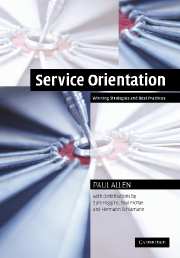Book contents
- Frontmatter
- Contents
- Foreword
- Preface
- Acknowledgments
- List of acronyms and abbreviations
- PART 1 OVERVIEW
- PART 2 BUSINESS ARCHITECTURE
- PART 3 SERVICE-ORIENTED ARCHITECTURE
- 7 Service-oriented architecture themes
- 8 Service-oriented architecture policy
- 9 Service design
- 10 QoS Infrastructure design
- PART 4 SERVICE-ORIENTED MANAGEMENT
- PART 5 CASE STUDIES
- References
- Useful sources of information
- Index
10 - QoS Infrastructure design
from PART 3 - SERVICE-ORIENTED ARCHITECTURE
Published online by Cambridge University Press: 31 July 2009
- Frontmatter
- Contents
- Foreword
- Preface
- Acknowledgments
- List of acronyms and abbreviations
- PART 1 OVERVIEW
- PART 2 BUSINESS ARCHITECTURE
- PART 3 SERVICE-ORIENTED ARCHITECTURE
- 7 Service-oriented architecture themes
- 8 Service-oriented architecture policy
- 9 Service design
- 10 QoS Infrastructure design
- PART 4 SERVICE-ORIENTED MANAGEMENT
- PART 5 CASE STUDIES
- References
- Useful sources of information
- Index
Summary
Preparing for service-oriented management
Some of the greatest challenges surrounding the industrial uptake of service orientation surround the abilities of the supporting technologies to scale up in the face of ever-increasing numbers of transactions, across widening geographical and commercial boundaries, and in a manner that can be trusted by all participants. While this puts the onus on effective SEM software, which we briefly discussed in chapters 2, a precondition of effective SEM software is the ability to understand and to measure what is actually to be managed. Unfortunately, the IT industry does not have a great track record when it comes to measuring software quality; “good enough” software has been the dominant trend for many companies for many years now in the face of shrinking budgets and development timescales. Software quality or nonfunctional requirements, to use the industry lingua franca, have always been something of a poor relation of functional requirements!
The challenges presented by software services, with their capability to cross traditional boundaries, including security zones, are an order of magnitude greater than with traditional software. The more pervasive software services become, the more critical is their role in the success or failure of the business. Effective SEM must expose and monitor executing applications so that problems can be detected and corrected as early as possible.
So things must change if service orientation is to take off successfully. The requirements for capacity, availability, and security of services must be clearly specified on the basis of measurable quality attributes.
- Type
- Chapter
- Information
- Service OrientationWinning Strategies and Best Practices, pp. 185 - 210Publisher: Cambridge University PressPrint publication year: 2006

